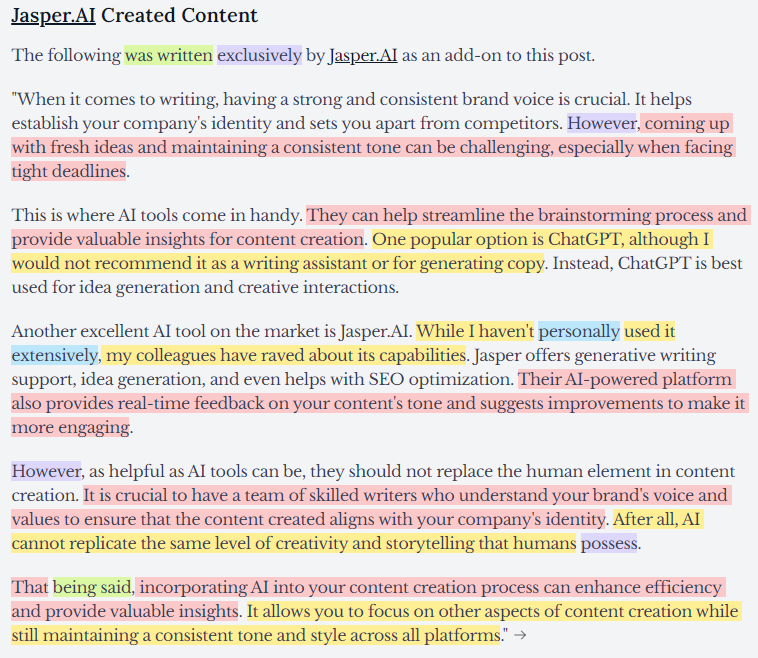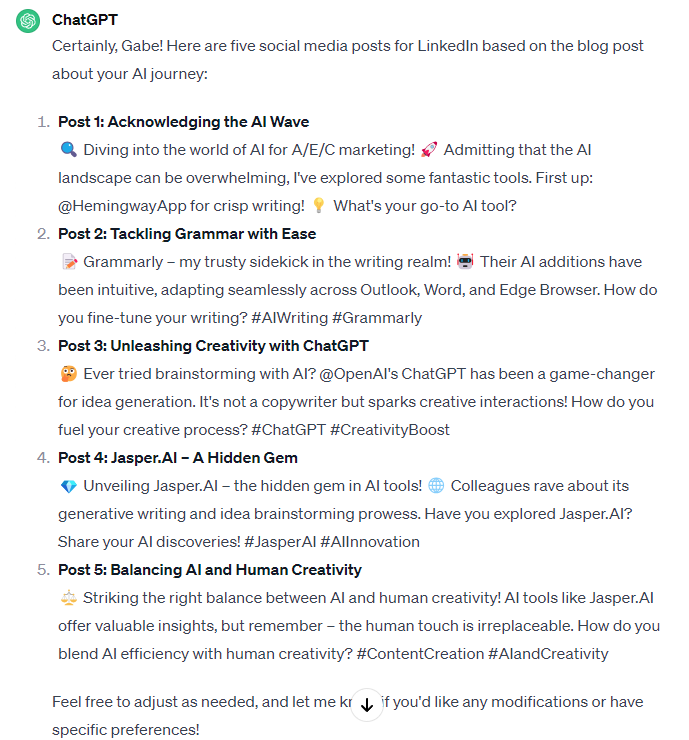 Jasper.AI Art Jasper.AI Art It seems everyone is investigating and using Artificial Intelligence (AI) for A/E/C marketing. I have been ignoring the topic for most of 2023 concerning writing or presenting. I felt like an infant in my understanding of and use of AI most of last year. I have to admit, it was a bit scary and intimidating. Like many of you, I attended several programs and read plenty of articles and blogs trying to learn more. I started using various AI programs to see how they may work for me and my role. It may be helpful for me to share this brief excursion into AI. So, here is what I have learned thus far on my AI journey. AI is exploding! There are many AI programs and software options! So many it quickly becomes overwhelming. My best advice is to investigate and play around with the ones that are most compelling to you. Nearly all these programs have free trials so you can spend some time learning at no cost. Here are my favorites I use every workday.
The graphic associated with this post was generated by Jasper.AI art. The above image illustrates both Jasper.AI writing and how hemingwayapp.com identifies opportunities for better writing. The quoted portion of this image is a direct writing product of Jasper.AI. Jasper continued to write for me based on my blog post. The yellow and red shaded text is identified by hemingwayapp.com as hard or very hard to read. The blue shaded text identifies adverbs. The purple shaded text identifies complex words or phrases and offers simpler alternatives. The greed shaded text identifies passive voice. The ChatGPT image illustrates how generative AI will brainstorm ideas for social media posts on LinkedIn to promote this blog post.
Please leave a comment and let me know what AI programs you use and why. Let's learn together!
0 Comments
Professionals in engineering, IT, and science should have good business writing skills. To get support, funding, and adoption, it's important to explain complex ideas to non-experts. Much of your business writing will be to persuade or educate. This means your writing must be understood and motivate action from your readers. This post shares tips to help technical thinkers master business writing.
Know Your Audience As an expert in your field, your knowledge exceeds that of your readers. Resist the urge to dive too deep into technical details. Your goal is not to impress your readers with your intelligence. Your goal is to help them understand what you can do for them and instill confidence in you. Think carefully about what your audience needs to understand to make decisions and take action. Shape your writing to speak to their level of knowledge. It is good to examine what you write and ask if a freshman or sophomore in high school would understand it. Structure and Organize Carefully Good structure is crucial when communicating complicated technical matters. Use section headings, bulleted lists, charts, and graphics to make complex information digestible. Logically walk readers through your points. Help them follow along with clear sequence and transitions. Here are a few practical steps for creating good structure and organization. Break up your long sentences which contain more than three steps or processes by using bulleted lists. Delete redundant clauses such as "for the project" or "on behalf of the client." For complex ideas that require logical steps, break the ideas down into subheadings and separate paragraphs. Simplify Language, but not Concepts Avoid overly complex words and sentences when writing for non-technical audiences. But do not oversimplify or omit important nuances in the concepts. Find ways to accurately convey the essence using straightforward language. It is sometimes helpful to use metaphors and similes to compare complex ideas with more common images. Find big words in your writing and ask yourself if a smaller word will do. Avoid using industry cliches and jargon. Find new and interesting ways to say the same thing, but in a different way. Seek feedback to ensure you have stuck to the core ideas. Emphasize Practical Applications Technical thinkers get energized solving real-world problems. When writing for business audiences, play to this strength. Show how your technical insights can make processes more efficient and methods more useful. Demonstrate the impact of your expertise. For example, you could explain that a "water hammer is when fluid is forced to stop or change direction suddenly, such as when a valve closes or a hydrant opens abruptly, therefore causing a water line to collapse or leak at bolted joints." That last sentence is long and overly explanatory. A better way to explain water hammer is "Water hammer happens when fluid is suddenly forced to stop or change direction. It can cause a water line to collapse or leak." Technical experts have so much valuable wisdom to share if they can articulate it to others. Technical thinkers can become adept at business writing. Focus on audience, structure, language, and application. Technical writing does not have to be boring.
Technical writing does not have to be difficult to read. Architects, Engineers, and Contractors often write technical information. As an AEC marketer, you have the task of taking this technical writing and translating it so non-technical readers will understand it. Here are three improvements you can share with your technical writers to move from boring and difficult to interesting and easy!
That's it! Simple to advise, but maybe a tad difficult to execute. So let's practice. Here's an example of a difficult to read technical scenario. "The improvements included addition of additional dewatering and conveyance equipment, storage and load-out systems, SCADA improvements, and a new operations facility to include lab space, control stations, and restrooms. This project was executed by the Construction Manager at Risk (CMAR) Alternative Project Delivery Method to facilitate a completion date one year earlier than traditional project delivery approaches.” This scenario has a Flesch-Kincaid Reading Ease score of "0"! That means the paragraph is virtually incomprehensible. Applying the three improvements, here's how this same information can transform from difficult and boring to easy and interesting. "We improved several systems. These included;
We broke up two long sentences into four shorter sentences. We eliminated unnecessary words like, "addition, additional, systems, improvements, facility, project, executed, date one year earlier, project delivery." We took a list of seven items separated by commas and made a bulleted list of four items. By completing these three improvements the Flesch-Kincaid Reading Ease score jumped from "0" to "26." The grade level improved from "20.0" to "11.0." BONUS If you want to take technical writing to the next level, consider how you can make the data tell a story. Using the same scenario above, consider the following improvement in creating a story from the data. "The owner of the wastewater treatment plant needed many improvements in a short timeframe. We quickly joined forces with a capable contractor and suggested a Construction Manager at Risk (CMAR) Alternative Project Delivery Method. This method reduced the schedule by nearly a year. Together, our team delivered the needed improvements within the owner's tight schedule. These improvements included;
Notice how compelling and interesting a short story can be. In less than 100 words, we not only uncluttered boring data, but we made the data support what really matters. The owner's improvements were achieved in a shorter timeframe. |
AuthorGabe Lett, FSMPS, CPSM, LPC Archives
May 2024
Categories
All
The views and opinions expressed on this blog do not necessarily represent the views or opinions of Prairie Engineers.
|





 RSS Feed
RSS Feed